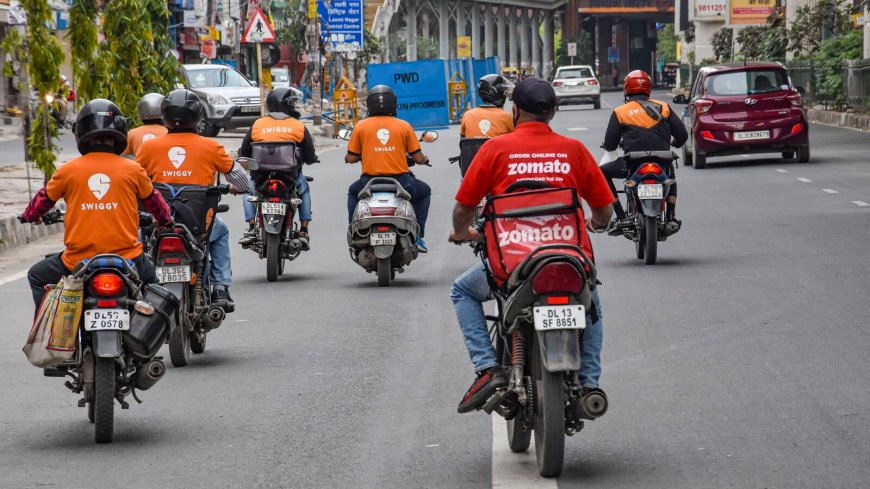Is Quick Commerce Eating into the Food Delivery Market? A Deep Dive into the Shift
Explore how quick commerce is reshaping the food delivery landscape, with platforms like Blinkit, Instamart, and Zepto leading the charge

Introduction: The Rise of Quick Commerce
Quick commerce (q-commerce) has emerged as a formidable force in the retail and food delivery sectors. Characterized by ultra-fast delivery times—often within 10 to 15 minutes—q-commerce platforms are redefining consumer expectations and challenging traditional business models. In India, companies like Zomato's Blinkit, Swiggy's Instamart, and Zepto are at the forefront of this transformation. But how is this rapid delivery model impacting the established food delivery market?(The Financial Express, News Minimalist)
Market Dynamics: Quick Commerce vs. Traditional Food Delivery
Growth Trajectories
Quick commerce platforms are experiencing exponential growth. For instance, Swiggy's Instamart reported a 56% year-on-year increase in gross order value (GOV) in Q1 FY25, reaching ₹2,724 crore. In contrast, Swiggy's traditional food delivery business saw a 14% growth in GOV during the same period .(Business News & Finance)
Similarly, Zomato's Blinkit leads the quick commerce market with a 46% share, followed by Zepto at 29% and Swiggy Instamart at 25% .(News Minimalist)
Consumer Preferences
A significant shift in consumer behavior is evident. According to GlobalData, 64% of Indian consumers prefer food delivery at least once a week, with a growing inclination towards q-commerce platforms due to their speed and convenience .(The Financial Express)
Operational Models: Dark Stores and Delivery Efficiency
Quick commerce platforms operate through dark stores—small, hyperlocal warehouses designed for rapid order fulfillment. This model enables them to offer delivery times of 10–15 minutes, compared to the 30–40 minutes typical of traditional food delivery services .(Snackfax)
The efficiency of q-commerce is further enhanced by the simplicity of its last-mile delivery model. While food delivery involves multiple stops per route, q-commerce deliveries often follow a one-to-many approach, allowing delivery partners to complete more orders per hour .(Snackfax)
Impact on Traditional Food Delivery Platforms
The rapid ascent of quick commerce is prompting traditional food delivery platforms to adapt. Zomato, for example, has launched Blinkit to tap into the q-commerce market. However, this expansion comes with challenges. In Q4 FY24, Zomato reported a 78% decline in profits, primarily due to heavy investments in Blinkit's expansion .(ETRetail.com, Reuters)
Similarly, Swiggy's traditional food delivery business experienced slower growth, with a 17% year-on-year increase in revenue, falling short of the company's 20% growth forecast .(Reuters)
Strategic Responses: Innovation and Diversification
In response to the growing dominance of quick commerce, traditional food delivery platforms are innovating and diversifying their services. Swiggy, for instance, introduced 'Bolt,' a 10-minute food delivery service that has scaled to over 400 cities .(afaqs!)
Zomato's Blinkit also ventured into the food delivery space with 'Bistro,' a dedicated app for delivering snacks and other food items within 10 minutes .(afaqs!)
Global Perspectives: Quick Commerce Beyond India
While India is witnessing rapid growth in quick commerce, the trend is also gaining traction globally. In the UK, Deliveroo has faced challenges from international rivals like Meituan's KeeTa, leading to its exit from the Hong Kong market .(Latest news & breaking headlines)
In the grocery sector, companies like Deliveroo are capitalizing on the growing demand for quick delivery services. This transition leverages existing delivery infrastructure and aims to increase profitability by delivering groceries in addition to meals .(Financial Times)
Future Outlook: Consolidation and Innovation
The quick commerce sector is expected to continue its rapid growth, with projections indicating a market size of $42–55 billion in India by 2030 . However, this growth may lead to consolidation, as smaller players struggle to compete with established giants like Blinkit, Instamart, and Zepto .(Snackfax)
Innovation will be key to sustaining growth. Platforms that can efficiently scale their operations, maintain service quality, and adapt to changing consumer preferences will likely lead the market.
Conclusion: A Paradigm Shift in Delivery Services
Quick commerce is undeniably reshaping the food delivery landscape. Its emphasis on speed, efficiency, and convenience aligns with the evolving demands of modern consumers. Traditional food delivery platforms must innovate and adapt to this new paradigm to remain competitive. The future of food delivery will likely be characterized by a blend of traditional and quick commerce models, each complementing the other to meet diverse consumer needs.
What's Your Reaction?
 Like
0
Like
0
 Dislike
0
Dislike
0
 Love
0
Love
0
 Funny
0
Funny
0
 Angry
0
Angry
0
 Sad
0
Sad
0
 Wow
0
Wow
0












































































